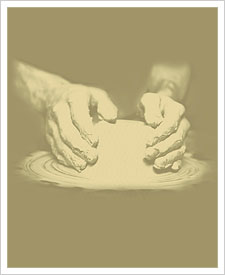|
|
|
 |
|
| |
Pottery and porcelain are materials made from earth and water and their forms are shaped by kneading clay. Due to firing, changes occur to the physical as well as the chemical properties of clay. An important discovery of man in terms of capitalizing from natural resources, the production of ceramics is still dynamic today.
Materials used to make pottery are easy to obtain and high temperatures are not required in the firing process. As a result, most ancient civilizations in the world are known to have produced pottery with their own unique characteristics. Due to its porous nature, pottery is permeable even when covered by a coat of low-fired glaze. When struck, pottery makes a dull sound. In ancient china, pottery was often used as building material, or for the creation of funerary objects and containers for sauces, minced meat, wine, and water.
Porcelain are made from a refined clay known as kaolin, that is first covered with a coat of gloss glaze, then fired at high temperatures. Abundant in kaolin clay, China was among the earliest civilizations to discover the secret of firing kaolin. Over time, varieties such as green wares and white wares appeared as different techniques developing gradually such as the application of under glaze and over-glaze, incised or pattern-imprinted moulds used to create decorative motifs. When stuck, they make a clear sound. Porcelain wares generally serve as dining utensils, containers, and decorations for display. They are also often used at ceremonies and religious events.
After sintering, the body and glaze of ceramics do not deteriorate easily as time goes by. As a result, shards from ancient sites can be seen as records of remote cultures. Researchers are also able to learn about ceramic-making techniques of various regions in different time periods by observing the marks left during the processes of production
|
|
 |
|
|
| |
|
|
| |
|
|
|

